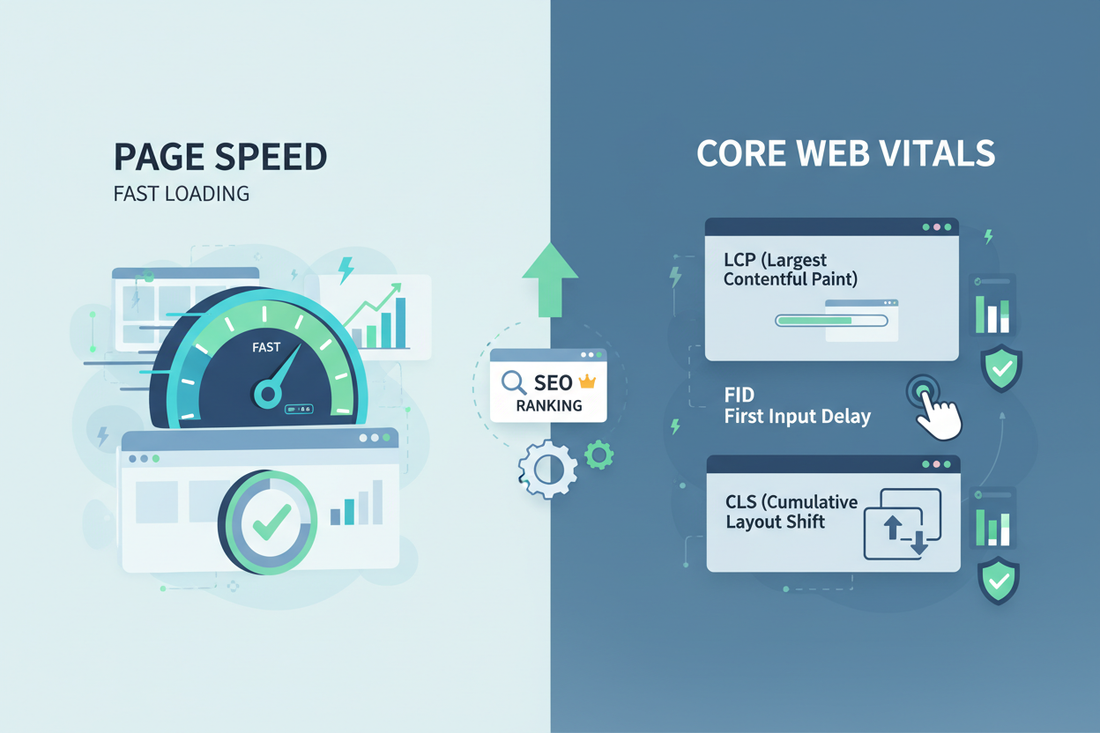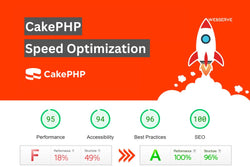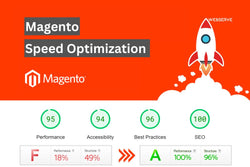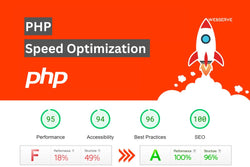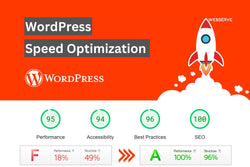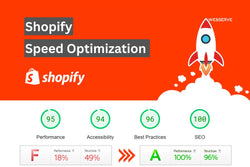In a digital age where users demand quick access, the speed of your site can be everything to its success. But what do you need to pay attention to — raw page load speed? Or the more nuanced metrics known as Core Web Vitals? And even though both — user experience (UX) and SEO are certainly two factors which impact the site, they are not same and how they influence each other is crucial for those good SEO gains. This article will break down their differences, explain how they affect rankings and conversions, and demonstrate the ways of speed optimization services — WordPress, Shopify, Magento, Laravel, Drupal, CakePHP, CodeIgniter, PHP, Yii, Symfony, Smarty PHP, Wix, Webflow, HubSpot, Squarespace, Joomla, HTML, BigCommerce, Weebly, Angular, Java, and React.
1. What is Page Speed vs. Core Web Vitals?
Essentially, page speed represents the total amount of time that a webpage takes to load. It’s a catchall — beginning when a user accesses your URL until all assets, scripts and imagery are fully loaded in the viewable area on their screen. It’s typically measured within tools such as PageSpeed Insights.
In contrast, Core Web Vitals (CWV) are a specific set of user-experience metrics that focus on the most meaningful parts of that load process:
-
Largest Contentful Paint (LCP) — how quickly the main content loads (target < 2.5 s)
-
Interaction to Next Paint (INP)/First Input Delay (FID) — responsiveness of the page to user actions (target < 200 ms)
-
Cumulative Layout Shift (CLS) — how stable the page layout is while loading (target < 0.1)
For example, if you optimized for total page load within 1 second but your main content is slow to appear (LCP > 4s), or clickable elements move around unexpectedly (CLS > 0.25), the user experience of your site is still low quality. That’s why CWV matters. CWV are one of the “page experience” ranking signals according to Google.
2. How They Impact SEO — What the Data Says
Here’s what the data and case studies show:
-
A report from Conductor noted that sites improving their CWV saw up to 8% more sales and bounce-rate drops of 20%+ when key metrics like LCP were improved.
-
An article explains that while CWV are ranking signals, they are not the dominant factor — content relevance and other user signals still matter most.
-
Investigations from sources like Lighthouse and PageSpeed show lab‐based performance scores vary greatly, but what Google uses for ranking is actual field data (real-user metrics) like CrUX.
Key takeaway:
-
Page speed improvements help reduce bounce rate and improve user signal metrics, which indirectly benefit SEO.
-
Core Web Vitals are direct signals of user experience that Google uses — they matter more when comparing two similarly relevant pages.
-
But great content + relevance will still out-rank a site with perfect CWV if the other site fails at relevance. Speed isn’t a silver bullet.
3. Where Should You Focus?
Focus A: Immediate wins via Page Speed
Start with these for quick impact:
-
Compress and optimize images → fewer bytes loaded → faster page.
-
Minify CSS/JavaScript/HTML, combine files when possible → fewer requests.
-
Enable browser caching & use a CDN → faster repeated visits.
This is where services like PHP website speed optimization or HTML speed optimization shine.
Even if you only get the load time down, you’ll see lower bounce rate, better engagement and indirectly better SEO.
Focus B: Deep wins via Core Web Vitals
Once page speed basics are handled, move to the meaningful metrics:
-
LCP: Ensure main content loads first, defer non-essential assets.
-
INP/FID: Ensure interactive readiness — avoid heavy main-thread blocking.
-
CLS: Reserve element space, avoid shifting content, manage fonts.
This is especially relevant for platforms like WordPress speed optimization, Shopify speed optimization, Magento performance optimization, Webflow performance optimization, React speed optimization, Angular speed optimization — where frameworks, themes and scripts can introduce instability.
4. Platform-Specific Considerations & Interlinking Opportunities
Platforms and frameworks each bring unique performance challenges:
-
WordPress speed optimization: heavy plugins/themes often hurt CWV.
-
Shopify speed optimization, BigCommerce speed optimization: third-party apps and scripts can increase INP and CLS.
-
Magento performance optimization: large store catalogs may delay LCP.
-
Laravel website optimization, Symfony speed optimization, Yii speed optimization, CodeIgniter speed optimization, CakePHP speed optimization: custom apps may ignore front-end UX without dev focus.
-
Wix speed optimization, Squarespace speed optimization, Weebly speed optimization: builder-platforms need cautious code injection to avoid layout shifts.
-
Webflow performance optimization, HubSpot speed optimization, Joomla speed optimization, HTML speed optimization: custom markup should still follow performance best practices.
-
React speed optimization, Angular speed optimization, Java website speed optimization: single-page applications (SPAs) must manage initial load, hydrating content and shifting layout.
5. Reporting & Measurement Framework
When optimizing speed and CWV, track:
-
Before/after metrics: LCP, INP/FID, CLS (via Search Console’s Core Web Vitals report)
-
PageSpeed Insights lab results (mobile + desktop)
-
Engagement & conversion metrics: bounce rate, time on page, conversion rate.
-
Crawl & indexation metrics (for large sites).
Report example: -
Baseline: LCP = 4.8s, CLS = 0.25, INP = 310 ms, PageSpeed mobile 45.
-
Post-optimization: LCP = 2.2s, CLS = 0.05, INP = 190 ms, PageSpeed mobile 82.
-
Business impact: Bounce rate ↓ 18%, conversions ↑ 12% within 30 days.
This direct tie between speed, CWV, and business KPIs helps make the case for performance optimization services
6. What Actually Matters for SEO?
-
Yes, page speed matters — faster pages improve engagement and make it easier for search engines to crawl and index.
-
Yes, Core Web Vitals matter — they are part of Google’s ranking signals and measure real-user experience.
-
But the heavy-hitter is relevance & content quality — speed alone won’t outrank superior content.
-
Use speed & CWV as a ‘tie-breaker’ or uplift mechanism — when your content is great, speed pushes you further ahead.
-
The most business-impacting path: combine site speed optimization, website performance optimization, and page speed optimization with high-quality, relevant content and good UX.
FAQs on Page Speed vs. Core Web Vitals
Q1: Can I rank well if my Core Web Vitals are poor but I have great content?
Yes. Relevance of content is still the foremost signal. Low CWV won’t be a roadblock to ranking altogether, but it might make you relatively weaker than competitors and harm user experience, which in turn can lower rankings.
Q2: Does a high PageSpeed Insights score guarantee good SEO rankings?
No. A high score is a good start, but lab scores (which PageSpeed reports) aren’t always representative of what you see in your real-user field data (CrUX). Google ranks using field data (75th percentile) not only lab scores.
Q3: Which metrics should I prioritise first — load time or visuals/layout stability
Prioritize the metrics that most closely map to user experience: LCP first (loading), then INP/FID (interactivity), and finally CLS (visual stability). Page load time is still essential but here are what is more important: UX & CWV.
Q4: How long until I see ranking improvement after I improve speed/CWV?
You’ll often see improved user metrics (such as bounce, engagement) within weeks. Rankings progress may be in weeks to months and are based on competition, crawl rate and strength of content.
Q5: Do single-page apps (SPAs) built with React or Angular have special CWV challenges?
Yes. SPAs usually load a lot of JavaScript and hydrate UI after FCP, both of which may block LCP/INP causing more CLS. Services such as React speed optimization and Angular speed optimization will need to be managing code splitting, caching, and pre-rendering in an optimized complete website way for a good CWV.
Final Word
Page speed and Core Web Vitals aren’t competitive metrics — they’re complementary ingredients in website performance and user experience. Concentrating on them aids in website speed improvement, site speed optimization & brings measurable business gains.
